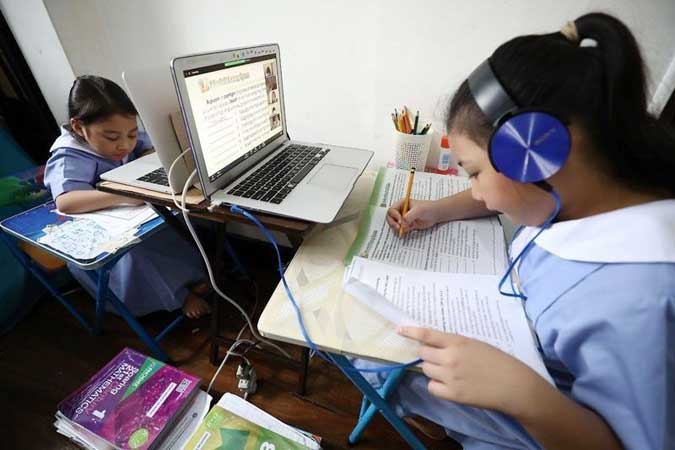Curriculum flexibility, teacher training, enhanced connectivity are keys to improving Philippine education

By Patricia Mirasol
According to educators at a July 14 education forum by the National Academy of Science and Technology (NAST), the keys to improving the quality of education in the country are: allowing schools to choose between a disciplinal or spiral curriculum, elevating the quality of training for teachers, and improving access to learning resources through enhanced internet connectivity.
CURRICULUM FLEXIBILITY
With a spiral curriculum, schools are only able to cover 40-75% of the curriculum, according to NAST academician, physicist, and Central Visayan Institute Foundation co-founder Christopher C. Bernido.
“Amend Republic 10533 to delete the provision of Section 5g that states, ‘The Curriculum shall use the spiral progression approach,’” he said. “A spiral curriculum is like watching the first 30 minutes of a movie in grade 7, the next 30 minutes in grade 8, [and so on]. Students have forgotten the foundations of the subject when continued after a year.”
A spiral curriculum is an approach to education that introduces key concepts to students at a young age and covers these concepts repeatedly, with increasing degrees of complexity.
“This could mean teachers being tempted to rush through subjects, or [give] superficial coverage that makes deep learning impossible for many,” Mr. Bernido said. “Essential and non-essential topics end up being given equal weight.”
In view of the pandemic, he recommended the emergency measure of allowing schools to choose between spiral and disciplinal curricula. In a disciplinal curriculum, a subject is tackled extensively per school year (e.g., general science in grade 7, biology in grade 8, chemistry in grade 9, and physics in grade 10).
“Allow schools to choose between disciplinal or spiral,” said Fr. Bienvenido F. Niebres, SJ, a mathematician and former president of Ateneo de Manila University (AdMU). AdMU has shifted to a disciplinal curriculum, he added.
“Allow schools to focus on those topics that are most essential,” Fr. Niebres told the forum audience. “Many physics and mathematics teachers know what to focus on. If they can only cover 60%, which 60% can they cover? Give teachers and schools the allowance to prioritize.”
According to Nepomuceno A. Malaluan, undersecretary and chief of staff of the Department of Education’s (DepEd) Office of the Secretary, Sulong Edukalidad is the department’s response to reforms in the immediate term. One of the four pillars of the reforms is a review and update of the K to 12 curriculums.
“We found that there is a space to differentiate between essential and desirable learning competencies, and to focus on the essential,” said Mr. Malaluan, as he shared updates on the curriculum review. “The review also revealed the need to improve sequencing, placement, and – in certain instances – the presence of prerequisites.”
TEACHER TRAINING
Another integral aspect of education is teacher training, said Sherwin T. Gatchalian, a senator and chairman of the Senate Committee on Basic Education, Arts and Culture.
According to the United Nations Educational, Scientific, and Cultural Organization, research has shown that teachers, more than any other constituent group in education, determine educational quality and student achievement.
“We are pushing for revival for congressional oversight for education, or EdCon for short,” he said. “Unang dapat solusyonan ang teacher training [We need to first address] teacher training.”
Senate Bill 2152, or the Teacher Education Excellence Act, aims to improve education by improving the quality of teachers and teacher education in the Philippines.
“This is already in the plenary,” Mr. Gatchalian said, adding that the bill also aims to empower the Teacher Education Council. “The training needs of teachers has to be a continuing deliberate endeavor.”
An education forum series that will tackle ongoing major reform initiatives for quality is in the works by the DepEd and its partners, said Mr. Nepomuceno. “Initial topics include best practices in blended learning, upskilling and reskilling of teachers, as well as contentious topics such as the language of instruction.”
INTERNET CONNECTIVITY
Section 1 of the 1987 constitution’s Article 14 is the guiding principle, said NAST academician and University of Santo Tomas vice–rector for research and innovation Maribel G. Nonato.
In light of the realities caused by this pandemic, she said, “quality education” now refers to “quality online education.” “Education accessible to all,” meanwhile, now also refers to technological capacity and internet connectivity.
An October 2020 BusinessWorld article reported that a majority of parents, or 8.8 million, preferred modular learning for their children last year, as this option was not reliant on gadgets or internet access.
The same article also noted a huge gap in internet speed between highly urbanized cities and rural areas — as much as 5.54 megabits per second (Mbps) versus 1 Mbps in Mindanao.
The Department of Information and Communications Technology should be put back under Department of Science and Technology, said Dr. Ester A. Garcia, president and chief academic officer of University of the East. “We have a good learning management system, but our students complain that it doesn’t reach them. Connectivity is very important. We can’t just blame the private sector for this.”
“I hope that the circumstances of COVID-19 would result in the planning of connectivity enhancement by the government,” Ms. Nonato told the forum audience. “We’re low at ICT (information and communication technologies) adoption. If we really intend to move towards hybrid learning, we have to act on this.”



